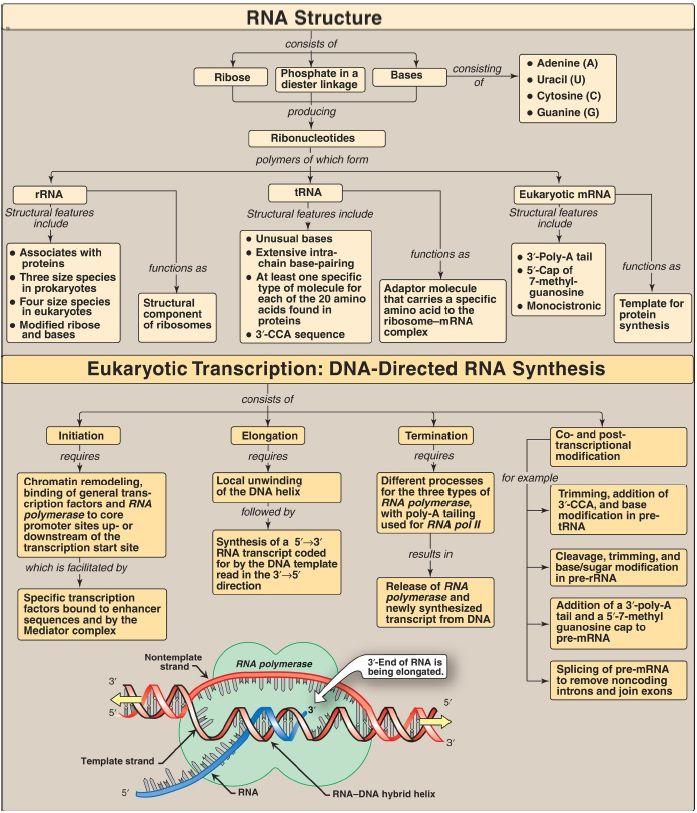
RNA structure and synthesis
 المؤلف:
Denise R. Ferrier
المؤلف:
Denise R. Ferrier
 المصدر:
Lippincott Illustrated Reviews: Biochemistry
المصدر:
Lippincott Illustrated Reviews: Biochemistry
 الجزء والصفحة:
الجزء والصفحة:
 27-12-2021
27-12-2021
 1664
1664
RNA structure and synthesis
Three major types of RNA participate in the process of protein synthesis: ribosomal RNA (rRNA), transfer RNA (tRNA), and messenger RNA (mRNA), as shown in Figure 1. They are unbranched polymers of nucleotides but differ from DNA by containing ribose instead of deoxyribose and uracil instead of thymine. rRNA is a component of the ribosomes. tRNA serves as an adaptor molecule that carries a specific amino acid to the site of protein synthesis. mRNA (coding RNA) carries genetic information from DNA for use in protein synthesis.
The process of RNA synthesis is called transcription, and the substrates are ribonucleoside triphosphates. The enzyme that synthesizes RNA is RNA polymerase (RNA pol). In prokaryotic cells, the core enzyme has five subunits (2 α, 1 β, 1 β′, and 1 Ω) and possesses 5′→3′ polymerase activity needed for transcription. The core enzyme requires an additional subunit, sigma (σ) factor, to recognize the nucleotide sequence (promoter region) at the beginning of the DNA to be transcribed. This region contains consensus sequences that are highly conserved and include the −10 Pribnow box and the −35 sequence. Another protein, rho (ρ), is required for termination of transcription of some genes. There are three distinct types of RNA pol in the nucleus of eukaryotic cells. RNA pol I synthesizes the precursor of rRNA in the nucleolus. In the nucleoplasm, RNA pol II synthesizes the precursors for mRNA and some noncoding RNA, and RNA pol III synthesizes the precursors of tRNA and 5S rRNA. In both prokaryotes and eukaryotes, RNA pol does not require a primer. Proofreading involves the polymerase backtracking and cleaving the transcript. Core promoters for genes transcribed by RNA pol II contain cis-acting consensus sequences, such as the TATA (Hogness) box, which serve as binding sites for transacting general transcription factors. Upstream of these are proximal regulatory elements, such as the CAAT and GC boxes, and distal regulatory elements, such as enhancers. Specific transcription factors (transcriptional activators) and Mediator complex bind these elements and regulate the frequency of transcription initiation, the response to signals such as hormones, and which genes are expressed at any given time.
Eukaryotic transcription requires that the chromatin be relaxed (decondensed) in a process known as chromatin remodeling. A primary transcript is a linear copy of a transcription unit, the segment of DNA between specific initiation and termination sequences. The primary transcripts of both prokaryotic and eukaryotic tRNA and rRNA are posttranscriptionally modified. The rRNA are synthesized from long precursor molecules called pre-rRNA. These precursors are cleaved and trimmed by ribonucleases, producing the three largest rRNA, and bases and sugars are modified.
Eukaryotic 5S rRNA is synthesized by RNA pol III and is modified separately. Prokaryotic and eukaryotic tRNA are also made from longer precursor molecules (pre-tRNA). If present, an intron is removed by nucleases, and both ends of the molecule are trimmed by ribonucleases. A 3′-CCA sequence is added, and bases at specific positions are modified. Prokaryotic mRNA is generally identical to its primary transcript, whereas eukaryotic pre-mRNA is extensively modified co- and posttranscriptionally. For example, a 7-methylguanosine cap is attached to the 5′-end of the mRNA through a 5′→5′ linkage. A long poly-A tail, not transcribed from the DNA, is attached by polyadenylate polymerase to the 3′-end of most mRNA. Most eukaryotic mRNA also contains intervening sequences (introns) that must be removed for the mRNA to be functional.
Their removal, as well as the joining of expressed sequences (exons), requires a spliceosome composed of small nuclear ribonucleoprotein particles (“snurps”) that mediate the process of splicing. Eukaryotic mRNA is monocistronic, containing information from just one gene, whereas prokaryotic mRNA is polycistronic.

Figure 1: Key concept map for RNA structure and synthesis. rRNA = ribosomal RNA; tRNA = transfer RNA; mRNA = messenger RNA.
 الاكثر قراءة في الكيمياء الحيوية
الاكثر قراءة في الكيمياء الحيوية
 اخر الاخبار
اخر الاخبار
اخبار العتبة العباسية المقدسة


